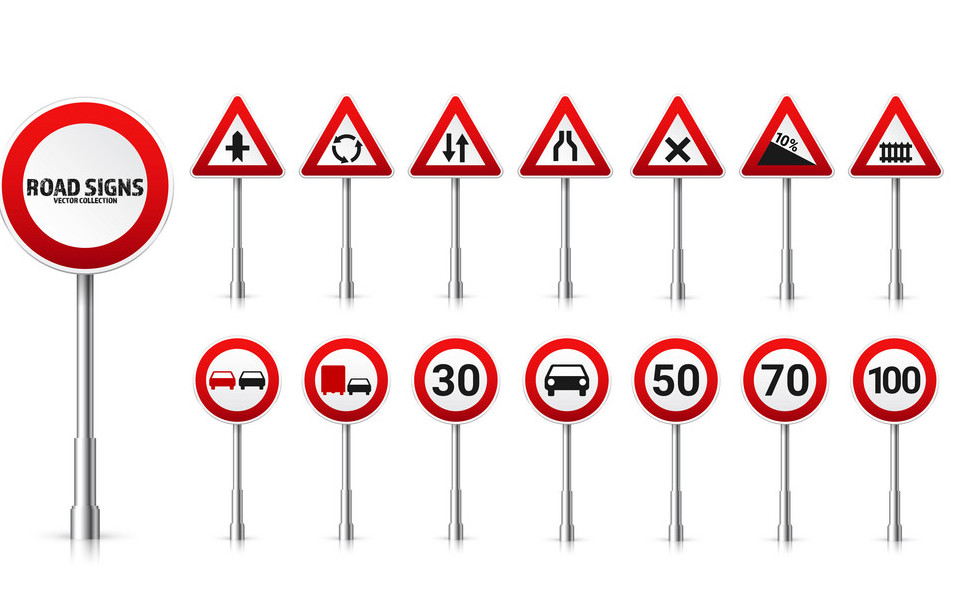Regulatory signs are fundamental to smooth and safe traffic. These kinds of signs convey information about road rules and traffic laws. They differ from informational and warning signs, which convey information about road conditions and driving hazards.
What kinds of messages will you see on a regulatory sign?
Every driver is familiar with:
- Stop
- Yield
- Slow
- Buckle Up
- Do Not Enter
- Keep Off Median
- Look Out for Trucks
- Lights on Next XX Miles
- Handicapped
- HOV Lane
- Weight Limit
- Fender Bender Move Vehicles
Regulatory signs do not always convey a command. Sometimes the driving rule is implicit. “Handicapped” and “HOV Lane” signs, for example, remind the driver to follow the rules about using handicapped parking spaces and high-occupancy vehicle lanes.
Excpetional Signs
Regulatory signs differ from signs that convey information rather than rules, such as:
- Slippery When Wet
- Bridge Icy in Winter
- Deer Crossing
- 15% Grade Ahead
The penalty for disregarding a regulatory sign, when drivers or pedestrians are apprehended by law enforcement, may either be a warning or a ticket. The penalty for disregarding an informational sign may be a crash or a pedestrian injury.
What Do These Signs Indicate?
Regulatory signs convey important rules through standardized language on signs that have familiar colors and shapes.
Urgent prohibitions are printed in white letters on red backgrounds.
Stop signs have white capital letters on a red background and an octagonal shape. Do not enter signs also have white capital letters on a red background. Yield signs are triangles pointing down, the word “YIELD” is printed in red letters on a white background with red edges.
Important regulatory information that applies to a stretch of the road rather than just to an intersection is printed in black on a white background. Speed limit signs post the maximum speed in black numbers on a white background on a rectangular sign.
And information about schools and traffic is printed in black letters on a yellow background. School crossing signs feature black icons for a parent and child on a yellow pentagon.
Regulatory signs as symbols
Regulatory signs are sometimes symbols. Drivers know that a red circle with a diagonal crossbar conveys the message “No.” Every driver has seen signs for no left turn, no right turn, and no U-turn.
In the United States, the federal Department of Transportation issues guidelines for the messages, colors, size, and shape of regulatory signs. Some states have their own huge engineering departments for producing blueprints for sign manufacturers and for doing studies of traffic safety for deciding where to put signs, but every state has to comply with the rules in the federal Manual on Uniform Traffic Control Device’s accompanying manual called Standard Highway Signs for choosing the look and size of their signs.
There are different rules for signs posted along single-lane roads, two-way roads, multiple-lane roads, and freeways.
For instance, a stop sign for a single lane of traffic can be 30 x 30*. A stop signs for a roadway that has multiple lanes of traffic must be 36 x 36″. A stop signs on a freeway maybe 48 x 48″.
A yield sign can be 36 x 36 x 36″ for a single lane road but must be 48 x 48 x 48″ for a two-way road and 60 x 60 x 60″ for an exit ramp from a freeway.
Where Are These Signs Usually Posted?
The placement of a regulatory sign can be a matter of engineering judgment.
Civil engineers specializing in transportation take into account pavement conditions, the slope of the road, the curvature of the road, lines of sight, traffic history, human factors, federal regulations, state law, and citizen inputs into account when they choose the location for posting regulatory signs. But sometimes laws and regulations overrule the best recommendations of engineers.
An example of this reality every traffic engineer understands is posting the speed limit. An engineer may determine that the maximum safe speed for a roadway is 80 miles per hour. But if state law makes 55 miles per hour the maximum speed for all roads of the same type, then the engineer is not going to be allowed to post an 80 mile per hour limit.
Signs that follow federal rules
Similarly, federal rules usually require that different regulatory signs be attached to different posts. But when it makes sense to place multiple regulatory signs together, federal rules allow other governments to save money by putting multiple regulatory signs on one post. A one-way sign might be posted with a sign prohibiting turns into oncoming traffic, for instance. Sometimes it is possible to put a stop sign on the same post as two street signs.
Some federal regulations are not intended to be interpreted literally. For instance, the DOT does not intend for its guidelines to overrule engineering judgment about where to place a hazard sign. The placement of roadway signage is a high-level professional skill that the public does not usually appreciate. Engineers are expected to keep the public safe and to satisfy regulators at the same time.
But at least part of the maintenance of signage can be easy. When you need to buy or rent signage, Worksafe has everything you need. We also provide sensors. Traffic signals, traffic cameras, airport control equipment, signposts, and hardware, as well as traffic cones, safety vests, and everything else you need for effective traffic control. Contact us online or call us at (802) 223-8948. We are ready to help you with all your traffic signage needs.



